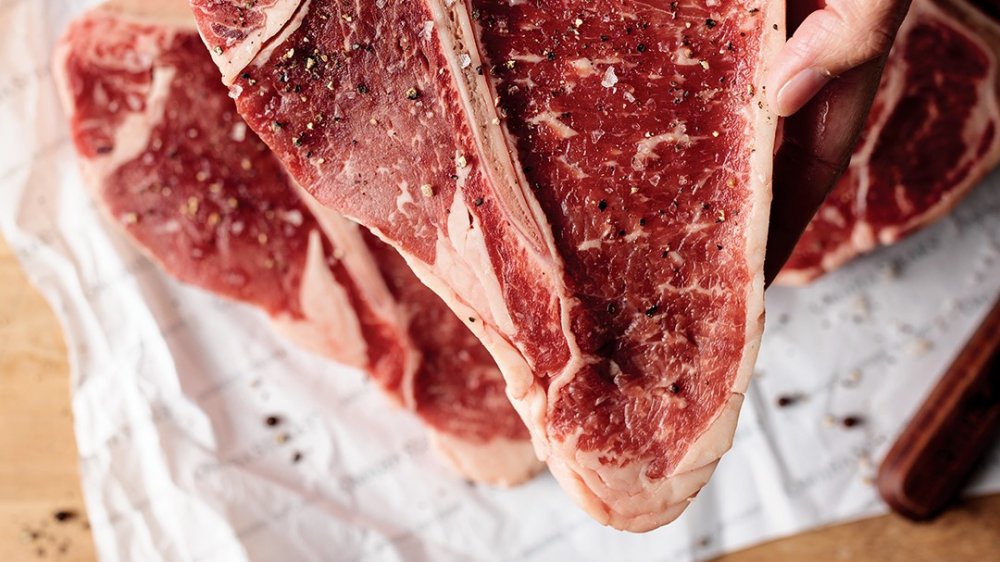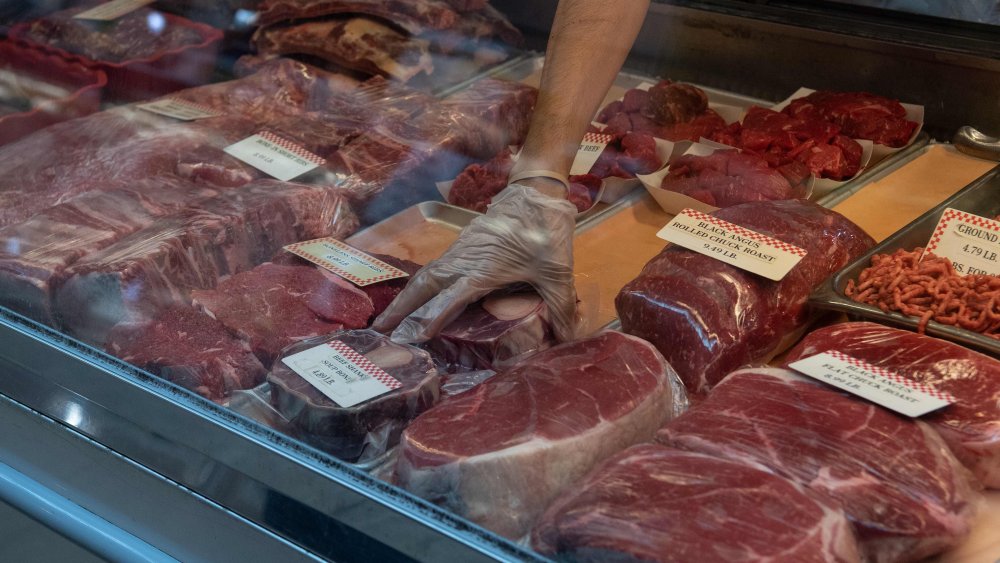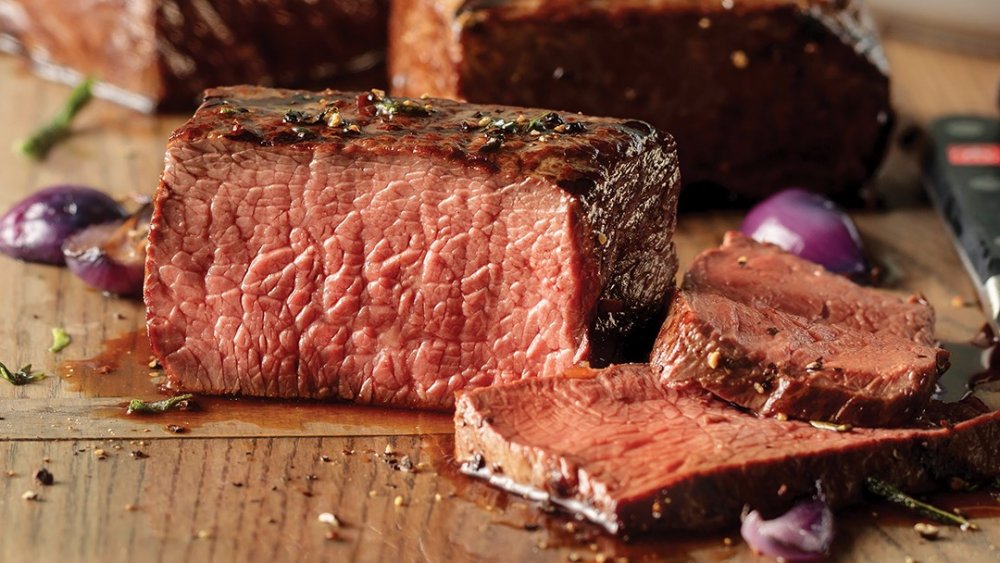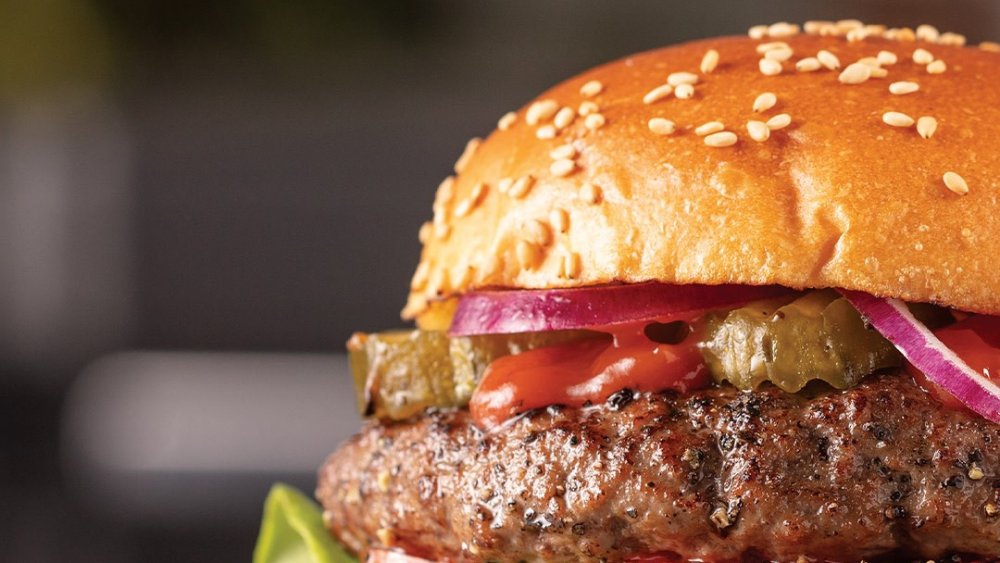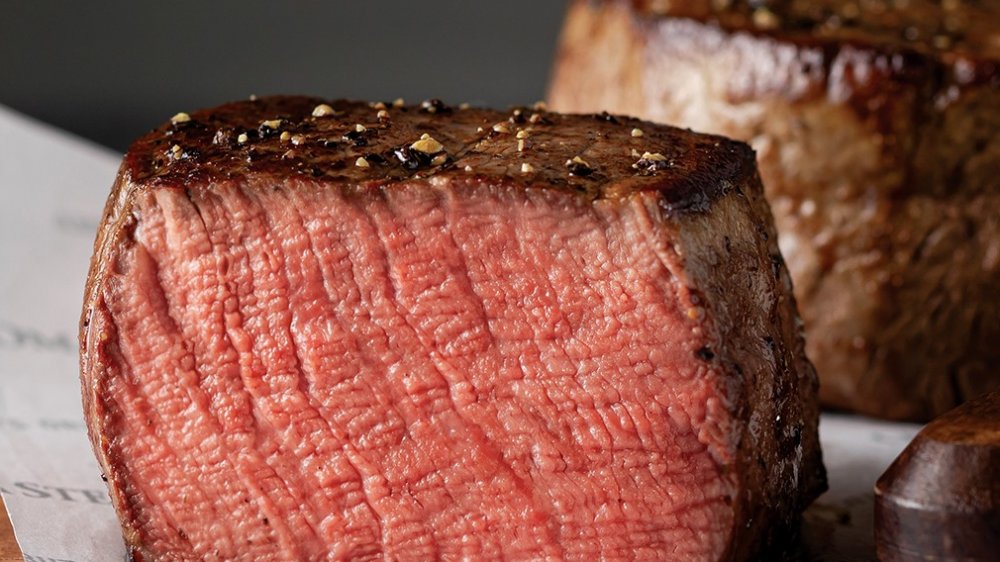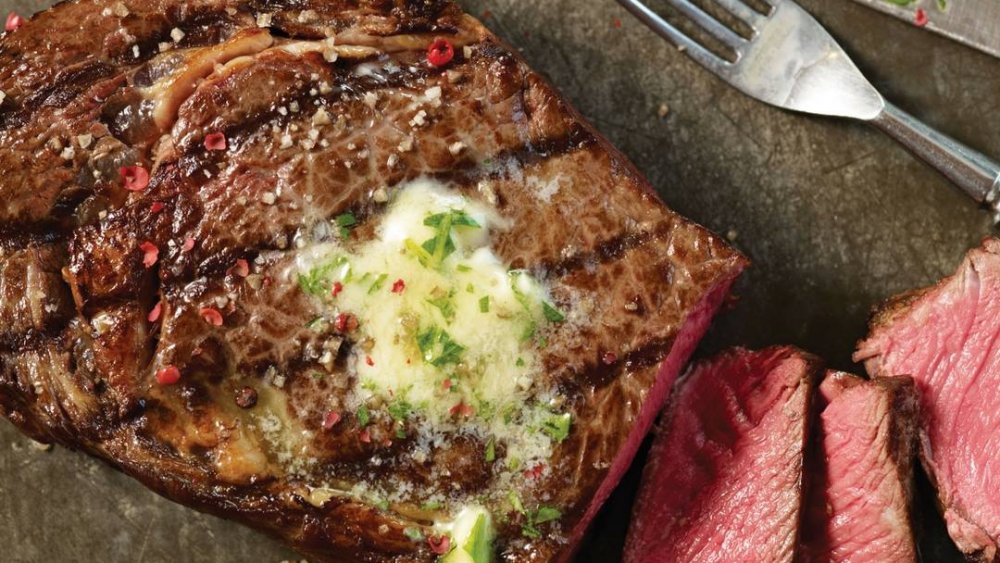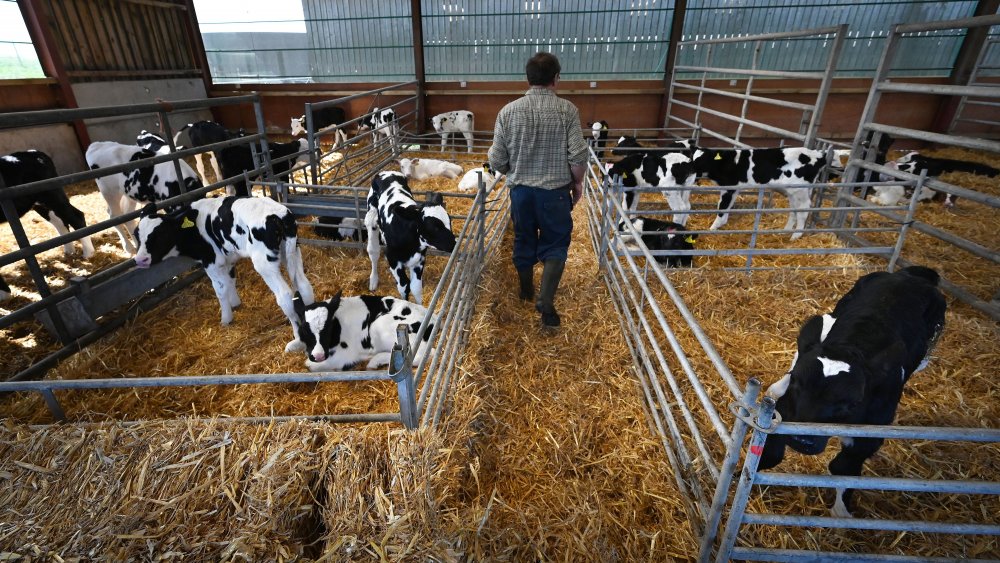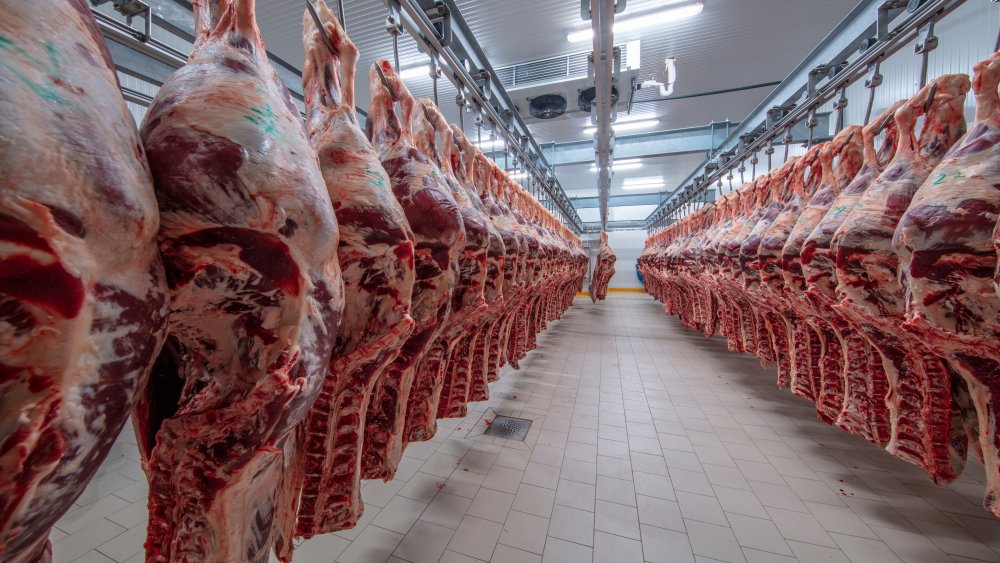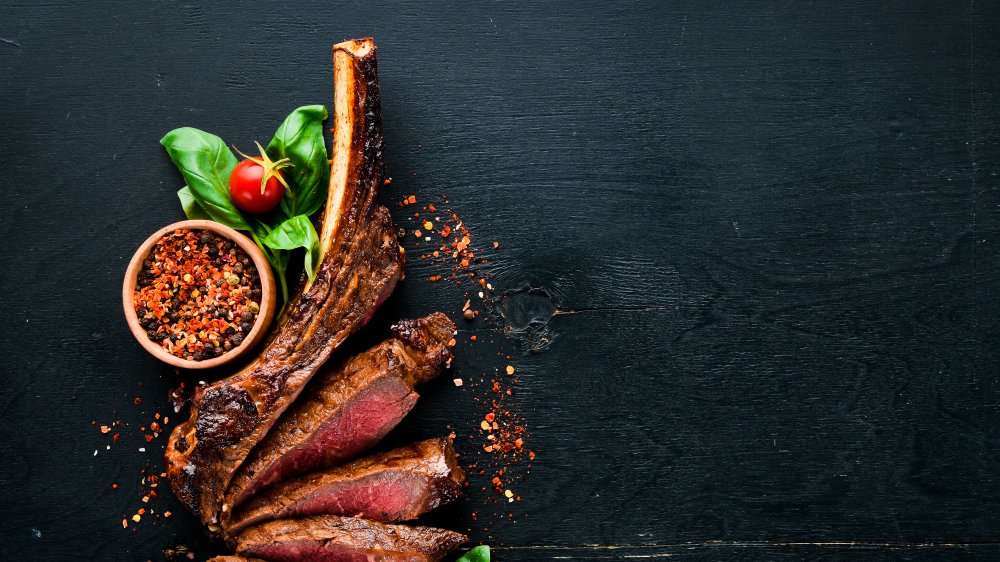The Untold Truth Of Omaha Steaks
Omaha Steaks has built a huge reputation for itself as one of the predominant mail-delivery meat companies in the United States. The company prides itself on providing Americans all across the nation with quality, Midwestern beef — not only that, but they've got a wide selection of other meat products, snacks, and even some fancy schmancy wines.
Having begun as a small mom-and-pop butcher shop in its namesake town, Omaha Steaks has since grown into a major meatpacking powerhouse, delivering steaks and other goods all across the lower 48 states. (Sorry, Alaska and Hawaii, but you'll have to pay additional fees if you want some Omaha Steaks beef.)
Meal delivery services have their pros and cons, but it can be hard to resist those mouth-watering t-bones and porterhouses that Omaha Steaks is so well-known for. Just what do you need to know about Omaha Steaks, though, before jumping the gun on that $300 Steakhouse Extravaganza box? From their humble beginnings to how the company is expanding into new markets, this is the untold truth of Omaha Steaks.
Omaha Steaks is a true rags to riches story
Believe it or not, Omaha Steaks hasn't always been the meat industry mainstay it is today. The Omaha Steaks story begins not in Omaha, Nebraska, but actually in Riga, Latvia, during the 19th century. When the Simon family fled Latvia due to fervent antisemitism in the country, they eventually wound up in Omaha, where they were among the first waves of Jewish people to make their way into the city, according to Tablet Magazine, a Jewish cultural magazine.
The Simon family patriarch J.J. Simon and his son B.A. worked together as butchers — which was the family trade back in their European homeland — founding the Table Meat Supply Company in downtown Omaha in 1917. The company grew in popularity among local Omahans, and eventually changed its name to Omaha Steaks in 1966 as the company expanded out to sell their product in other states via the Union Pacific Railroad.
More than a hundred years after Omaha Steaks' first inception as a company, the food delivery service has grown all across the nation, raking in around half a billion dollars in revenue as Tablet reported back in 2017. According to the Omaha Steaks website, the company has become the country's largest direct response marketer of beef and gourmet food. Talk about fulfilling the American dream!
For five generations, Omaha Steaks has been a family business
In the company's century-long history, Omaha Steaks has remained a Simon family enterprise — the current CEO and owner, Bruce Simon is the great-great-grandson of Omaha Steaks founder J.J. Simon. Simon has grown up in the family business and used to accompany his father to the plant as a child before working there during summer breaks from high school and college. This made Bruce Simon a natural choice to step into the position, as he had served various other positions within the company until 1994, when he became president and CEO.
Unlike other meat industry giants like Tyson Foods and Oscar Mayer, Omaha Steaks remains a privately owned company, meaning that investors cannot purchase shares of Omaha Steaks. While going public is typically looked at as a huge accomplishment for any major company, remaining a private, family-owned business has allowed the company to focus more on its long-term strategies, rather than constantly worrying about quarterly earnings.
The Omaha Steaks inventory has expanded beyond just beef products
The name "Omaha Steaks" is, admittedly, quite a bit misleading. While beef might be what comes to mind when you first hear the company's name, you might be surprised to find that you can actually get a much wider range of specialty products. In the 1960s, Omaha Steaks began expanding its catalog from only offering steaks to also include premium cuts of pork, poultry, and seafood. Since then, they've added an even more extensive range of products to the menu, as the company's delivery services have become much more widespread.
While steaks are still the prime cut of meat at Omaha Steaks, you can actually purchase a huge range of products besides their signature beef as well — from Polish-style kielbasa to hearty wild halibut fillets. They've even got an expansive set of accoutrements to serve alongside the main course, including charcuteries and potato-based side dishes, as well as some decadent wines. Perfect for your next steak dinner. Or your next kielbasa dinner. Or your next halibut dinner.
Dry ice plays a key role with Omaha Steaks
Ever wonder how Omaha Steaks manages to keep their products fresh, even while they're shipping them all the way across the country? As Dr. Youling Xiong wrote in Lawrie's Meat Science, "Raw meat is one of the most shelf-unstable food materials due to its abundance in nutrients ideally suited for microorganisms." This means that transporting uncooked steak products from state to state (and sometimes country to country) takes a lot of care.
When the company began its mail-order operations in 1952, they settled on using wax-lined cartons filled with dry ice to keep the meat cool — essentially mimicking a refrigerator. (This was before polystyrene shipping containers and vacuum packaging had become especially widespread commercial technology, you see.) As polystyrene and vacuum packaging became more popular and mainstream, Omaha Steaks ditched the wax-lined containers and began using those, in conjunction with dry ice as the means of keeping the meat cool.
Vacuum packaging, combined with the dry ice, ensures that the meat has no exposure to air — and thus, bacteria — while the dry ice keeps the temperature down low without requiring any electricity.
Omaha Steaks has expanded into the pet food market
Does your dog whine and beg every time you throw a steak on the grill? Next time you stock up on some Omaha Steaks, you might want to consider grabbing some of their signature dog treats, which the company added to their inventory just around 17 years ago. As The New York Times reported in 2004, customers were constantly telling the company's management that they were feeding scraps from their Omaha Steaks products to their dogs and cats. Eventually, the company gave in and decided to capitalize on their popularity with pets and began making dog treats themselves in 2003.
Now, these pet treats aren't some downgraded, poor-quality meat scraps leftover from the higher quality cuts of meat meant for humans. As the former owner of the company Todd Simon told The New York Times, "We're basically using the exact same product for humans without the high sodium content and some other spices." According to the Times, the company's dog treats very closely resemble Omaha Steaks' trademark beef jerky product, minus all the salt.
A little goes a long way at Omaha Steaks
Omaha Steaks is quite well-known for its lavish and pricey boxes of food. For example, some of these boxes, like their Gourmet Stock-Up Package, which features filet mignon, sirloin, chicken breast, and many, many more meats and side dishes, will cost you a couple of hundred dollars. While these are great deals for doomsday preppers, chances are, you don't need to be spending that much on some fancy meat that you probably can't get rid of fast enough.
That said, Omaha Steaks has plenty of more reasonable packages for the everyday diner — as Business Insider reported in 2018, $20 can actually go a long way over at Omaha Steaks. For starters, it's hard not to find at least a couple of promotional sales on their website. But also, you can typically grab a pack of eight sausages (from Polish-style kielbasa to classic beef franks) for around — and a lot of times, just below — $20. The same goes for certain cuts of beef, like their tenderloin tips.
But what's the point of a cheap steak if it doesn't taste any good? As Business Insider reported, the quality of what you get at Omaha Steaks typically surpasses that of what you can find in your local supermarket. If you've got the extra cash to spare and want to go to a local butcher or steakhouse, then, of course, you can't beat that — but Omaha Steaks might just be the next best thing.
Omaha Steaks got in trouble for violating telemarketing laws
Perhaps you've gotten a call or two from a robocaller at Omaha Steaks trying to sell us on their holiday gift box special that's stuffed to the brim with gourmet hamburgers and tri-tips galore. Well, in 2014, one man in Gresham, Oregon, had received just one call too many, as The Oregonian reported.
According to The Oregonian, Michael Hetherington received 10 unwarranted calls to his cell phone from the company over the course of just a little over a month in 2013. Hetherington did some research on laws surrounding telemarketing and realized that the company could be breaching the Telephone Consumer Protection Act of 1991. The act essentially states that companies aren't allowed to call customers without their permission nor can they use automated programs to dial up random numbers — with added emphasis in regards to protecting cell phone numbers. This is exactly what Omaha Steaks was doing when they called Hetherington those 10 times and he filed a lawsuit against them in 2014.
The lawsuit grew into a wider class action suit and was eventually settled about two years later in 2016, when the company had to shell out $5 million to customers they'd called in violation of the TCPA. According to Top Class Actions, a website investigating various class action suits across the country, customers began receiving checks from Omaha Steaks for around $40 in December 2016.
Omaha Steaks ran into trouble over their website
When you hear about the Americans with Disabilities Act, it's usually in reference to physical entities — you know, things like wheelchair ramps, parking spots, or restroom accessibility. But one little known fact about the ADA is that websites also have a vague set of rules they must follow in order to be in compliance with the act.
Some advocacy groups have been known to take businesses to court if their websites aren't easily accessible for blind users. However, because these rules aren't quite set in stone (the ADA was enacted years before the Internet had become a major facet of American life), these cases are often gauged on a case-by-case basis.
See, if a business's website isn't rendered properly so that it can be easily read using text-to-speech software, that essentially leaves the website useless and inaccessible for someone who's visually impaired or blind. The Omaha World-Herald reported in 2017, that the advocacy group Access Now had partnered with three blind would-be customers to sue Omaha Steaks for a number of accessibility issues with their website.
The company, however, claimed that it was planning on doing a complete renovation job on the website later in 2018 and did not want to update its website until it rolled out the full update. The lawsuit was terminated shortly after it began, as the ADA is relatively vague with regards to internet compliance.
Omaha Steaks has had retail stores for decades
You're probably most familiar with the Omaha Steaks website, or maybe even their mail catalogs; after all, it's primarily known as a delivery service. But it does have a handful of brick-and-mortar shops across the United States as well. According to the Omaha World-Herald, the first Omaha Steaks retail store opened up in the company's hometown in 1976, as a "pilot for possible similar operations throughout the country." Prior to opening up shop in downtown Omaha, customers could only purchase Omaha Steaks through the mail or at select restaurants carrying their products.
Though it was a pilot project, the company didn't really begin expanding its brick-and-mortar presence beyond Nebraska for nearly a decade. In 1985, the first retail shop outside of the Cornhusker State opened up in Houston, Texas. (Nowadays, Texas has surpassed even Nebraska as the state with the most Omaha Steaks stores.) The company has since opened up more than 75 locations across the nation, so if you're looking to get your hands on some Omaha Steaks, and you need them fast, you may just be able to drive on down to your nearest location to stock up for the next family cook-out.
Omaha Steaks sources their beef from farms in the Midwest
According to data from the National Agricultural Statistics Service, Nebraska has a grand total of 6.3 million cattle, meaning that bovines outnumber people in Nebraska by three-to-one. That's more cattle in the state than there are people in the entire city of Los Angeles!
In fact, Nebraska is the state with the second-highest cattle to people ratio (South Dakota is first, with about 4.5 cattle for every person in the state) — so you know they take their beef seriously over there. According to Omaha Steaks, this beef-centric ethos is what's kept them in the state throughout their century-long history.
"This is the heart of beef country, and we love to share that quality with the rest of the country," reads a 2019 blog post on the company's website.
The company prides itself on sourcing all of its beef from farms throughout the heartland of the United States, and not outsourcing anything from cheaper, far away locations in South America or Australia. According to the company, all their steak products come from grass-fed, grain-finished beef — another factor that helps boost the quality of your Omaha Steaks box-set.
Omaha Steaks workers are considered essential during the COVID-19 crisis
When the COVID-19 outbreak hit the United States, a number of meat processing facilities all across the nation found themselves in the center of controversy. Workers at these plants were considered essential, and as such, many meat processing companies did not shut down their operations, according to a report from National Public Radio. Most notable has been Tyson Foods, which, according to Business Insider, had been linked to around 4,500 COVID-19 cases nationwide.
Omaha Steaks wasn't quite in the clear either. Per an April 2020 press release, Omaha Steaks continued operations at its facilities and the company said it would be working to maintain social distancing measures at its facilities while also allowing all staff at its plants paid sick leave. As of May 2020, Omaha Steaks has not been linked to any COVID-19 cases like some of its competition, but the attitude among its workers has been "primarily fear," as Eric Reeder, president of the union representing workers at both Omaha Steaks, Tyson, and Nestlé among others, told the Omaha World-Herald.
Omaha Steaks has been giving back during the pandemic
Although it may seem like a cold and distant corporate entity, at its core, Omaha Steaks still adheres to the mom-and-pop ethos that its founder J.J. Simon fostered when he first made his way to the United States. And a big part of that is giving back to the Omaha community — the Simon family maintains close ties to the city, carrying out various acts of service throughout Omaha and its surrounding regions.
The most recent example of that? The company's response to the COVID-19 outbreak. According to local news outlet NBC 6, Omaha witnessed huge spikes in unemployment in response to the COVID-19 pandemic. For example, during the week of April 4, 2020, more than 25,000 people filed for unemployment (for a bit of context, the city of Omaha has just a little less than half a million people).
In response, the Omaha Downtown Improvement Group partnered up with local businesses — Omaha Steaks included — to provide meals for a drive-thru food pantry to help out those who were struggling with unemployment as a result of the crisis (via the Omaha World-Herald). While organizers were initially looking for discounted prices on food to give out, Omaha Steaks reportedly refused to accept a single cent for any of the hamburger or pork chops that the company doled out.
